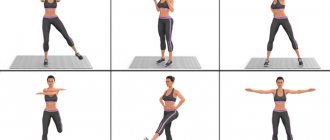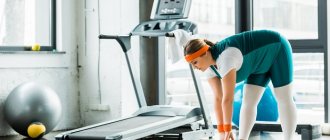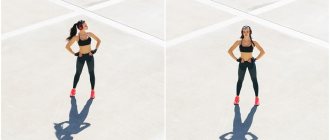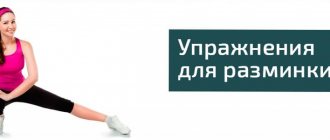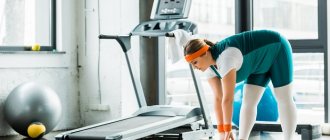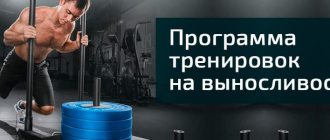A pre-workout warm-up is a set of exercises to prepare your body for physical activity, which will help you avoid injury and perform the workout as efficiently as possible. The main purpose of warming up is to gradually increase body temperature and warm up muscles that are in a state of inactivity.
We offer you a selection of warm-up exercises and a ready-made sequential plan for performing them. These exercises are equally suitable for warming up at home, at the stadium or in the gym.
Why do you need a warm-up?
As you know, all organs and systems of the human body are in an inert state and do not begin to function at the required level immediately. Performing simple warm-up exercises is designed to prepare the muscles for the main exercises. If you neglect this set of exercises, you can get serious injury during training. Warm-up is a mandatory stage of any workout. Morning exercises, evening exercises, aerobics, yoga and even dancing begin with a light warm-up. If you don't warm up before your workouts, they will not only become traumatic, but will also be ineffective. Every body needs moderate physical activity every day. Warm-up exercises take from 3 to 15 minutes, while they raise tone, charge you with positive energy and improve health. They activate muscles and joints, stimulate blood circulation, improve the body's oxygen balance and metabolism. To achieve good results, they must be performed regularly.
WARM-UP BEFORE TRAINING: BENEFITS AND FEATURES
Warming up before exercise should be an essential part of your exercise program if you want to exercise effectively and with minimal risk of injury. Ideally, the pre-workout warm-up should last 10-15 minutes. But usually people don’t want to spend a lot of time on warming up, so you need to devote at least 5 minutes to it. So, 5 minutes is the mandatory minimum that must be devoted to warming up before training.
Before moving directly to the selection of exercises, it is important to consider the benefits and features of warming up before training.
WHAT ARE THE BENEFITS OF WARMING UP BEFORE WORKOUT?
- Warming up helps warm up your muscles. A warmed muscle becomes more elastic, which helps avoid sudden strains, tears and other injuries during training.
- Warming up before exercise improves performance and the rate of muscle contraction, which improves the performance of your entire body during physical activity.
- A good warm-up before exercise speeds up your heart rate and increases blood circulation. Through the blood, the heart supplies oxygen to the muscles, thereby helping your muscles work during the activity. Plus, oxygen helps increase muscle endurance.
- Warming up increases joint flexibility and mobility and improves range of motion. This way, common injuries such as sprains and joint dislocations can be avoided.
- Warming up before exercise helps speed up nerve impulses. This means activating the nervous system and improving reflexes.
- The benefits of warming up aren't just limited to the physical. Warming up helps you mentally prepare for training, gently immerse yourself in sports activities, step back from everyday worries and focus on the activity. All this has a positive effect on the training process.
WHAT IS THE FEATURE OF WARMING UP BEFORE WORKOUT?
- Warm-up before training should include: exercises with dynamic stretching (not static), exercises to warm up the joints (joint exercises), exercises to warm up the body (light cardio). Those. You should include exercises in your warm-up that work a large number of muscles, warm up the body and improve range of motion.
- The pre-workout warm-up should include, on the one hand, simple exercises that are suitable for gently preparing your body for stress, but on the other hand, intense enough to warm up the muscles well and prevent injuries.
- Don't confuse warm-up and cool-down! They don't have to be the same. Your post-workout cool-down should include muscle stretching exercises, usually static ones. The purpose of a cool-down is to calm the body after exercise. While the task of warming up before training is to warm up the body and prepare it for the load.
- Static stretching exercises (i.e. where you hold in one position, stretching a muscle) should not be the basis of your warm-up. Static stretching relaxes the muscles, which is completely undesirable before training.
- The minimum warm-up time is 5 minutes. If you are expecting a serious strength or intense workout, then do not regret 10 minutes for warming up.
- One warm-up exercise is performed on average for 15-30 seconds. Exercises are performed sequentially, without rest between them. Do not forget to perform all exercises symmetrically on the right and left sides.
- Even if you plan to train only certain muscle groups, it is still advisable to warm up your entire body. But the muscle groups being trained can be given more attention during the warm-up.
WHO IS THIS SELECTION OF WARM-UP EXERCISES SUITABLE FOR?
The warm-up suggested below is universal. This means that it is suitable for everyone and will be appropriate before any workout: cardio, strength, HIIT, crossfit, calisthenics, Tabata, outdoor running, mixed training. This workout is also quite suitable as a morning exercise.
- If you're only training your upper body, you can increase the number of repetitions of those exercises that stretch your arms, shoulders, and core (arm raises, arm rotations, bending, wrist rotations).
- If you're training your legs, you can increase the number of repetitions of exercises that work your lower body (squats, lunges, knee and hip rotations).
- If you are planning strength training with heavy weights, then you can additionally perform exercises from a special warm-up. That is, for example, you plan to squat with a barbell weighing 30 kg. Accordingly, before the first approach, perform 10-15 squats with an empty bar or with a light bar (3-6 kg).
How to choose warm-up exercises
The choice of exercises depends on which muscle groups will receive the main physical activity. Each person, when carrying out physical activity, pursues specific goals: some want to lose weight and exercise mainly on cardio equipment, others want to achieve sculpted muscles and practice squeezing weights, others play sports such as football or hockey and their main load falls on their legs. The complex is selected depending on which muscle group needs to be trained, but even if training is not planned, it is worth doing warm-up exercises to improve the body’s functioning, relieve stress and relax. There are even a special set of exercises for relaxation. The positive effect from them will be noticeable with 2 classes per week, but it is still better to train daily.
Warm-up in class
The main rule is that warm-up should never be ignored. Warm-up in a physical education, fitness, dance, choreography lesson is a simple and necessary thing. It is this that allows you to prepare your muscles for physical exercise and protects children from getting all sorts of injuries during exercise. It is with a light warm-up that morning exercises, daytime exercises and even evening workouts should begin. If you look into any gym or sports hall, hall, where fitness classes and dance training (folk, modern, oriental, Latin American, etc.) are regularly and professionally held with the obligatory dynamic and static exercises, any physical activity begins with warm-up. WHAT IS A WARM-UP Warm-up is a set of exercises that are performed at the beginning of a workout to warm up the body, develop muscles, ligaments and joints. This is the basis of physical education, and it should cover the whole body to the maximum. It is necessary to take time to warm up immediately at the beginning of the lesson. This type of activity is relevant for children involved in sports or dance classes. Warming up before more serious physical activity should occur from the top of the body down. What is meant here is that first the neck muscles are warmed up, then the tissues of the upper limbs, torso, hips, knees and ankles. This sequence helps to avoid pinched nerves. Children 1-2 years old are just learning to navigate well in space and control their musculoskeletal system, so the warm-up consists of the simplest exercises. Here are some examples:
1. Stand opposite the child and make rotational movements with your head at a slow pace. Let the child repeat. You need to stretch your neck to avoid unpleasant pinched nerves when turning your head sharply.
2. After this, place your feet shoulder-width apart and begin to stretch your shoulder joint. Place one hand on your side, and with your free hand make five rotational movements in an arc. Then change hands and repeat the exercise.
3. To warm up the shoulder girdle, you can clap your hands, above and below. And then stretch your whole body upward.
4. Another good exercise for warming up children of this age is simply climbing onto a chair. Place a chair in front of your baby and let him begin to climb onto it, first standing on his toes and leaning on the seat. Then let him throw his knee, smoothly pull himself up to the back of the chair and climb onto it completely. Watch how your baby performs the exercise and constantly support him. It is advisable to repeat this exercise three times. Important! Show your child the exercises by example , so it will be easier and clearer for him to perform them.
Breathing exercises
- Breath of the sun. While inhaling, you should stretch your whole body upward, and while exhaling, return to the starting position. Repeat 8 times.
- Moon extension. Place your right hand on your belt, pull your left hand up and, as you exhale, bend to the right. Repeat on the other side. Perform the exercise 8 times left and right.
- Dolphin. While inhaling, spread your arms to the sides, while exhaling, bring them together in front of you, tilt your head and stretch forward.
Outdoor switchgear complexes for physical education homework
Homework for physical education
COMPLEX No. 1
.
- A set of daily morning exercises
.
Repeat each exercise 6-10 times.
1.I.P. (Starting position) - standing, arms along the body. Walk in place, speeding up, then slowing down. 1 min.
2.I.P. - standing, raise your arms up, take your leg back onto your toes - bend over - inhale, lower your arms, put your leg down - exhale.
3.I.P. - standing, arms out to the sides, circular movements of the arms in the shoulder joints back and forth, do not hold your breath.
4.I.P. – legs apart, right arm up, two bends springily to the left, change the position of the hands.
5.I.P. - standing, spread your arms to the sides - inhale, grab yourself by the shoulders - elongated exhale.
6.I.P. - standing, legs apart, hands on the waist. Lunge to the side, arms forward - exhale, return to IP - inhale.
7.I.P. - standing. Arms straight in front of you, reach your right hand with the toe of your left foot, do not bend your knees.
8.I.P. - standing, arms down. Jump your legs apart, clap your hands above your head.
9.I.P. - standing, easy running in place with transition to walking. 30 sec.
10.I.P. - standing, arms along the body, spread your arms to the sides - inhale, bend forward slightly, lower your relaxed arms and swing them - exhale.
COMPLEX No. 2
- A set of exercises to form correct posture.
The exercises of this complex can be performed from 1 to 6 times a day, repeating each of them 4-5 times at a slow pace, until pain is severe (if any), with the maximum possible range of motion. At first, the tension should be from 2 to 4 seconds, gradually increase to 8-10 seconds.
1
.I.P. (Starting position) - legs apart, hands in front of the chest, fingers clasped. Turn your torso, head, arms to the right; then stretch your arms forward, turning your hands with your palms away from you, with a static delay to the right, exhale. Same to the left.
2.
I.P. - the same. Hands forward, then, turning your torso and head to the right, move your right elbow back, turning your hands with your palms facing away from you. With your left hand, press your right hand with tension (while looking at your right elbow so that the neck muscles tense), exhale. Same to the left.
3
.Turn your torso to the right, raise your arms above your right shoulder, turning your hands with your palms facing away from you. Press your right hand with your left hand and exhale. Same to the left.
4.
I.P. - stand with your legs apart, hands behind your head, fingers in a “lock.” Turn your torso to the left, spread your elbows, bend into a knee position, bring your elbows together, tilt your head down, press the back of your head with your hands several times. Same to the right.
5
.I.P. - stand with legs apart, hands down in a “lock”. Make a circle with your hands to the right, turning your hands outward. Same to the left.
6
.Exercises with a gymnastic stick. I.P. - legs apart, gymnast. stick below. Turning your torso to the right, extend your right arm up and to the side. Press the stick with your left hand and exhale. Same to the left.
7
.I.P. - legs apart, stick down, grip from above. Raise your arms up above your head, make three body tilts forward, three back, three to the right, three to the left, then three body turns to the right and three to the left. After each series of movements, exhale.
8
.I.P. - legs apart, stick behind the back below. Make three turns of the body to the right, pressing the stick on the left thigh. Same to the left.
9.
IP - feet together, stick on shoulders. Make three body tilts to the right, left, forward and back, then three turns of the body to the right and left, while bending your knees. After each series of movements, exhale.
10
.I.P. - sitting on his heels, hands in front of him. Place your right hand over the top behind your back, and your left hand through the bottom, hands in a “lock”. Hold the pose for 5 seconds. The same thing by changing the position of the hands.
11
.I.P. - lying on your back, arms along the body. Slowly regroup and take a deep breath. Exhale slowly, returning to I.P.
COMPLEX No. 3
- A set of exercises to develop flexibility
All exercises should be performed in order without breaks or with very short ones if you really want to take a break. Exercise No. 1: Place your feet shoulder-width apart, hands on your waist. Perform tilts left and right. 12 times. Exercise No. 2: Place your feet shoulder-width apart, hands on your waist - circular rotations with your torso. 8 times left, 8 times right.
Exercise No. 3: Place your feet together, hands on your knees - circular rotations with your knees. 8 times left, 8 times right. Exercise No. 4: Bend one leg forward, hands on the belt - circular rotations with the leg bent at the knee. 8 times with one leg, then 8 times with the other leg. Exercise No. 5: Put your feet together - bend forward. Perform 12 springy movements. Exercise No. 6: Place your feet at double shoulder width - bend forward. Perform 12 springy movements. Exercise No. 7: Lunge to the side. Shift your body weight to your right leg, extend your left leg, then change the position of your legs. 12 times. Exercise No. 8: Place your feet one and a half shoulder width apart, grab your feet with your hands, trying to squat as low as possible, straightening your back and moving your pelvis forward. Perform for 1 minute. Exercise No. 9: Get on your knees, clasp your hands. Perform squats left and right, alternately touching the floor with your buttocks. 6 times in each direction. Exercise No. 10: Sit on the floor, join your legs together and perform 12 springy forward bends. Exercise No. 11: Sit on the floor and spread your straight legs to the sides, perform springy bends forward. 12 times. Exercise No. 12: Sit on the floor, stretch your left leg, bend your right leg and move it back, bend forward. Do 12 springy bends and change legs. Exercise No. 13: Sit on the floor, weave into a “lotus” and bend forward. 12 times. Exercise No. 14: Sit on the floor, bring your feet together, then spread your legs to the sides with your elbows. 16 times. Exercise No. 15: Lie on your stomach, bend your elbows. Straighten your arms, bend your back, lift your head up. Stay in this position for 30 seconds. Exercise No. 16: Lie on your stomach, hold your feet with your hands. Bend your back, lift your head up. Stay in this position for 30 seconds. Exercise No. 17: Lie on your stomach, bend your knees. Straighten your arms, bend your back. Stay in this position for 30 seconds. Exercise No. 18: Place your feet together and bend forward. Stay in this position for 30 seconds.
COMPLEX No. 4
4. A set of exercises to develop movement coordination.
1.Standing at the mirror, hands up - inhale, lower - exhale.
2. Double hand forward, left to the side, then change hands.
3.Touch the tip of your nose with the index finger of your left hand, then with your right, with your eyes closed.
4. Hands to shoulders, right leg to the side on the toe, arms to the sides, put your foot. Then also with the right foot.
5. Rolling the ball with one foot, then the other.
6.Walking with high knees.
7. Throwing a small ball into a hoop.
8. Hit the ball into the target, first with one hand, then with the other.
9. Throwing a ball over your head while walking in a circle.
10. While standing, throw the ball up, make a full turn of the body and have time to catch the ball.
11.Arms to the sides, legs together. Stand on one leg for 5 seconds, then on the other.
12.Walking and breathing exercises.
COMPLEX No. 5
- A set of general developmental exercises without subject matter.
Repeat each exercise 6-10 times.
1.I.P. (Starting position) - standing, arms along the body. Walk in place, speeding up, then slowing down. 1 min.
2.I.P. - standing, raise your arms up, take your leg back onto your toes - bend over - inhale, lower your arms, put your leg down - exhale.
3.I.P. - standing, arms out to the sides, circular movements of the arms in the shoulder joints back and forth, do not hold your breath.
4.I.P. – legs apart, right arm up, two bends springily to the left, change the position of the hands.
5.I.P. - standing, spread your arms to the sides - inhale, grab yourself by the shoulders - elongated exhale.
6.I.P. - standing, legs apart, hands on the waist. Lunge to the side, arms forward - exhale, return to IP - inhale.
7.I.P. - standing. Arms straight in front of you, reach your right hand with the toe of your left foot, do not bend your knees.
8.I.P. - standing, arms down. Jump your legs apart, clap your hands above your head.
9.I.P. - standing, easy running in place with transition to walking. 30 sec.
10.I.P. - standing, arms along the body, spread your arms to the sides - inhale, bend forward slightly, lower your relaxed arms and swing them - exhale.
COMPLEX No. 6
- A set of exercises to prevent flat feet.
2 times a day for 20 minutes Repeat 8-10 times
1.Check your posture.
2.Walking with correct posture.
3.Walking on tiptoes, hands on waist.
4.Walking in a cross step.
5.Walking on the outer arch of the foot “clubfoot”.
6. Standing with a gymnastic stick with an overhand grip, feet shoulder-width apart, rise on your toes, stick up - stretch.
7.Place the stick up, behind the shoulder blades, up again, lower.
8.Walk sideways on a stick, hands on the belt.
9. Stick from behind, with an underhand grip, pull the stick back, bring your shoulder blades together, rising on your toes, small jerks of the body.
10. Stick on the shoulder blades, squats with a straight back.
11. While sitting on a chair, bend your toes.
12.Raking sand, feet shoulder-width apart, arch of the foot.
13. Shifting small objects with the left and right foot.
14. Sitting on a chair, hands behind your head, get up from the chair, stand, sit down again.
15.Standing, hands on waist, roll from heel to toe.
16. Sitting on a chair, arms to the sides - inhale - bend forward, reach for your toes - exhale.
17.Free walking. Standing, hands up - inhale, hands down - exhale.
COMPLEX No. 7
- A set of exercises for physical education.
A)
walking in place with arm movements;
b)
pull-up exercises;
V)
jumping or running in place;
G)
bending or turning the body;
d)
squats, lunges back and forth, to the sides;
e)
different movements of the arms up, to the sides, in a circle;
and)
exercises to relax the muscles of the arms and torso;
h)
walking in place with attention tasks.
COMPLEX No. 8
- A set of exercises to prevent myopia.
To prevent myopia, special eye exercises can also be used.
A-1
I.p. (Starting position) - standing, hands behind, fingers locked. 1-2 - moving your arms and head back, bend over - inhale. 3-4 - in i.p. - exhale. Repeat 4-6 times.
I.p. - standing. Frequent blinking for 10-15 seconds.
I.p. - standing, hands to shoulders. Circular movements in one direction and the other. Repeat 6-8 times in each direction.
I.p. - standing, keep your head straight. Look up, then down, without changing the position of your head. Repeat 6-7 times.
I.p. - standing, 1 - half squat; 2 - i.p. Repeat 10-12 times.
I.p. - standing, hold your finger in front of your nose at a distance of 25-30 cm, look from a distant object (look out the window) to your finger and back for 30-40 seconds. Do it immediately.
A-2
1. I.p. (Starting position) - standing. 1 - move your bent arms back, connect your shoulder blades - inhale, 2 - arms forward, as if hugging yourself - exhale. Repeat 8-10 times.
I.p. - standing. Close your eyes, close your eyes tightly for 1-2 seconds, then open your eyes. Repeat 8-10 times.
I.p. - standing, hands to shoulders. Circular movements in one direction and the other. Repeat 6-8 times with each hand.
I.p. - standing. Circular movements of the eyes in one direction and the other. Repeat 10-15 times in each direction.
I.p. - standing, legs apart. 1-3 - bend the body to the side and return to the i.p. repeat 4-6 times in each direction.
I.p. - standing, hold the index finger of your right hand in front of your nose at a distance of 25-30 cm. Look at the finger for 4-6 seconds, then close your eye with the palm of your left hand for 4-6 seconds. Look at the finger with your right eye, then close your left eye and look at the finger with both eyes. Do the same, but close your right eye. Repeat 4-6 times.
COMPLEX No. 9
- A set of general developmental exercises with a subject (subject of choice)
Exercises with a small ball:
1. I.p. – o.s. ball in left hand. 1-2 – outward arcs, arms up, 3-4 – outward arcs, arms down, pass the ball behind your back to your right hand, exhale (8 times).
2. I.p. – stand with legs apart, arms to the sides. The ball is in the left hand. 1. tilt to the right leg, hands down, pass the ball to the right hand behind the leg, exhale, 2. – IP, inhale. 3-4 – the same to the left leg, passing the ball to the left hand (10 times).
3. I.p. - Same. 1-2 – torso to the right, hit the ball on the floor behind the right leg and catch the ball with both hands, 3-4 – IP, ball in the right hand, 5-8 – the same to the other leg (10 times).
4. I.p. - stand with your feet apart and hold the ball with both hands. 1-2 – toss the ball, sit down and catch it with both hands, exhale, 3-4 – toss the ball and standing up, catch it, inhale, (12 times)
5. I.p. – legs apart, ball in left hand. 1 - tilt to the right, hands behind the head, ball in the right hand, 2. IP, ball in the right hand, 3-4 - the same to the left (12 times)
6. Breathing exercises (3 times).
7. I.p. — Sit your arms to the sides, the ball in your left hand. 1 - swing your left leg up, arms forward, pass the ball under your foot to your right hand, exhale, 2 - lower your leg, arms to the sides, 3 - bend your arms behind your head and pass the ball to your left hand, inhale, 4 - arms to the sides, 5-8 same with the other leg. (12 times).
Exercises with a jump rope:
1. I.p. Stand with legs apart, jump rope folded into four at the bottom. 1 – tilt, arms forward, exhale, 2-3 – arms up, rope taut, look forward, inhale, 4 reps, pause. (4-6 times).
2. I.p. Wide stance with a rope folded in half at the bottom. 1 – arms forward, 2 – pull the rope, turn the body to the right, 3 – arms forward, 4 – IP, 5–8 the same to the left (6-8 times).
3. I.p. - Same. 1-2 – arms up, squat, exhale, 3-4 – i.p. inhale. (10-12 times)
4. I.p. — o.s. A jump rope folded into four behind the head. 1-2 – bend forward, bringing your arms together, exhale, 3-4 – straighten up, spread your shoulders, inhale. (4-6 times).
5. I.p. – stand with your legs apart on the rope, arms to the sides – down. 1-2 – deep squat, arms to the sides, exhale 3-4 – i.p. inhale. (8-10 times)
6. I.p. – stand with legs apart. Folded jump rope on the neck. 1-3 – three springy bends to the right, straighten the right arm, left behind the head, 4 – IP, 5-8 – the same in the other direction (8-10 times).
7. I.p. – sitting, legs bent, folded jump rope on the floor to the left. 1-2 – turn to the left (facing the rope), rest on your knees, 3-4 – sit on the other side of the rope, 5-8 – do the same in the other direction. (6-8 times).
8. I.p. – sitting, legs apart, arms to the sides, jump rope folded into four behind the head. 1-2 – turn the body to the left, 3-4 – IP, 5-8 – the same to the right. (6-8 times).
9. I.p. –o.s. folded jump rope in fours at the bottom. 1-2 – bend your left leg and step over the rope, 3-4 – IP, 5-8 – do the same with your right leg. (6-10 times).
10. Slow walking. For every fourth step, bend down, relax your arms, and exhale. (40-60 seconds)
Exercises for the pectoral muscles and back
- Raise of hands. Bring your hands together in front of you, keeping your feet shoulder-width apart. Inhaling deeply, raise your arms above your head and exhale as you return to the starting position. Lifting back is done in the same way. In the starting position, the hands are joined behind the back.
- Raising hands. Feet shoulder width apart. The arms are straightened at chest level directly in front of you, then, while inhaling, they are spread as far behind the back as possible, bringing the shoulder blades together. During exhalation, the arms return to their original position, the shoulder blades move apart, and the back rounds.
WARM-UP BEFORE TRAINING: 20 EXERCISES
The pre-workout warm-up we offer includes 20 exercises that will allow you to thoroughly, effectively and fully prepare your body for sports stress. Just consistently perform the exercises one after another - and your warm-up is ready.
The description suggests the number of repetitions if you warm up for 5 minutes or 10 minutes. However, the time for this warm-up may differ from that indicated, since the pace of the exercises will depend on you. In the future, you can always adjust the number of repetitions to suit your needs and time capabilities.
Remember to do the exercise on the right and left side. If this is a rotation, then you need to do it both clockwise and counterclockwise. The exercises are performed sequentially one after another; rest between exercises is not necessary.
The warm-up included the following exercises:
- Arm raises with shin overlap: 10 arm extensions
- Arm rotation with shin overlap: 5 arm rotations in each direction
- Arm raises with knee raises: 10 arm raises
- Abduction of arms to the side: 5 abductions of arms on each side
- Side bends: 5 bends on each side
- Leg bends: 5 bends on each side
- Back rounding: 8 reps
- Squat twists: 5 twists on each side
- Hip rotations: 5 rotations in each direction and on each leg
- Pelvic rotations: 5 rotations in each direction
- Knee rotations: 5 rotations in each direction
- Leg swings: 10 swings for each leg
- Squat: 10 squats
- Side lunges: 5 lunges in each direction
- Back lunges: 5 lunges in each direction
- Foot rotation: 5 rotations in each direction and on each leg
- Jumping jacks: 10 leg raises on each side
- Jumps with arms and legs raised: 15 jumps
- Running with shin overlaps: 15 “overlaps” on each leg
- Breathing recovery: 5 reps
The number of repetitions above is based on a total warm-up time of 5 minutes.
ARM BREAKDOWN WITH SHIN CLOSES
We begin the warm-up with a simple exercise that involves both the upper and lower body. Place your feet wider than shoulder-width apart, arms spread wide to the sides. Start taking steps with your shins overlapping, trying to touch your buttocks with your feet. At the same time, cross your arms over your chest, as if you are trying to hug yourself. Spread your arms as wide as possible, bringing your shoulder blades together.
- How much to do (for a 5-minute warm-up): 10 arm raises
- How much to do (for a 10-minute warm-up): 20 arm raises
ARM ROTATION WITH SHIN CLAP
We continue to perform steps with the shin overlapping. But now, at the same time, we begin to rotate our arms, stretching our shoulder joints and warming up our arm muscles. Rotate your arms with maximum amplitude; these should not be sluggish arm swings.
- How much to do (for a 5-minute warm-up): 5 arm rotations clockwise and counterclockwise
- How much to do (for a 10-minute warm-up): 10 arm rotations clockwise and counterclockwise
ARM LIFT WITH KNEE LIFT
This simple exercise activates your entire body. Raise your arms up, feet shoulder-width apart. Begin to raise your knees until your thighs are parallel to the floor. At the same time, lower your arms down, bending them at the elbow. Feel how your pulse begins to increase and your body warms up.
- How much to do (for a 5-minute warm-up): 10 arm raises
- How much to do (for a 10-minute warm-up): 20 arm raises
ABSOLUTION OF HANDS TO THE SIDE
We continue warming up the upper body by moving the arms to the sides. Place your palms on your waist and spread your legs wider than your shoulders. Start moving your arms out to the side as if you were trying to touch the wall to your side with your fingers. Try to twist with your core, not your whole body. Do the exercise dynamically.
- How much to do (for a 5-minute warm-up): 5 arm abductions in each direction
- How much to do (for a 10-minute warm-up): 10 arm abductions in each direction
TILTING TO THE SIDE
This simple exercise can be performed not only to warm up before training, but also as part of light gymnastics throughout the day. Bends to the side are a good stretch for the spine, supporting your posture and relieving stress from your back. To perform it, place one hand on your side, the other extended upward. Start leaning alternately in one direction and the other, stretch your arms down. When bending, try to work with your body, not your pelvis.
- How much to do (for a 5-minute warm-up): 5 bends in each direction
- How much to do (for a 10-minute warm-up): 10 bends in each direction
TILTING TO THE LEGS
Spread your arms out to the sides, legs wider than shoulder-width apart. Start bending towards the floor, twisting your body and trying to touch the floor with your fingertips. Do not round your back when bending, it remains straight. Bring your shoulder blades together. This exercise perfectly warms up the muscles of the arms, back, and back of the thigh.
- How much to do (for a 5-minute warm-up): 5 bends in each direction
- How much to do (for a 10-minute warm-up): 10 bends in each direction
ROUNDING THE BACK
When warming up before training, it is very important not to forget to pay attention to warming up your back. To do this, let's do a very simple, enjoyable exercise. Take a semi-squat position, hands on your hips, slight arch in your back. Begin to straighten and at the same time round your back in the thoracic region. Feel your spine come alive. Do the exercise dynamically.
- How long to do (for a 5-minute warm-up): 8 reps
- How much to do (for a 10-minute warm-up): 16 reps
SQUAT ROTATIONS FOR BACK AND SHOULDERS
Sit in a deep sumo squat with your feet wide apart and your knees and toes pointing out to the sides. Place your hands on your knees. Start twisting and turning your body to the side so that you lie on the thigh of first one leg, then the other. Bring your shoulder blades together, feel how the muscles of your chest, shoulders, and back are warming up.
- How much to do (for a 5-minute warm-up): 5 turns in each direction
- How much to do (for a 10-minute warm-up): 10 turns in each direction
PELVIC ROTATION
Let's perform several “rotational” movements from joint gymnastics, which will help us stretch the muscles, joints and ligaments of the lower body well. Let's start with pelvic rotations. Place your hands on your waist and begin to make rotational movements with your pelvis, as if describing a circle. Perform clockwise and counterclockwise rotations.
- How much to do (for a 5-minute warm-up): 5 clockwise and counterclockwise rotations
- How much to do (for a 10-minute warm-up): 10 clockwise and counterclockwise rotations
LEG ROTATION
Rotation of the legs perfectly warms up the hip joints, which are extremely important to stretch well before training to avoid injury. Try to rotate your legs with the greatest amplitude, while keeping your core stable. Remember to repeat the rotation back and forth on each leg.
- How much to do (for a 5-minute warm-up): 5 clockwise and counterclockwise rotations on each leg
- How much to do (for a 10-minute warm-up): 10 clockwise and counterclockwise rotations on each leg
ROTATION OF THE KNEES
The knees are the most vulnerable part of our joint-ligamentous system, so never forget to warm them up before training. Knee rotations are an excellent joint gymnastics exercise; you can perform them even on non-training days to prevent knee pain. Perform clockwise and counterclockwise rotations.
- How much to do (for a 5-minute warm-up): 5 clockwise and counterclockwise rotations
- How much to do (for a 10-minute warm-up): 10 clockwise and counterclockwise rotations
SWING YOUR LEGS
Leg swings are ideal for warming up. This very simple exercise perfectly warms up and warms up the leg muscles. Stand straight with your hands on your waist. Start swinging your leg back and forth, trying to lift your legs higher. The stronger the amplitude of this warm-up exercise before training, the better you will warm up. However, you shouldn't try too hard to avoid straining your muscles. If you have good balance, you can avoid touching the floor with your foot.
- How much to do (for a 5-minute warm-up): 5 leg swings on each leg
- How much to do (for a 10-minute warm-up): 10 leg swings on each leg
SQUATS
Squats are also great for warming up the muscles in your legs and buttocks. In our exercise, we will additionally involve the upper body in the work by swinging our arms. It is advisable to squat until your thighs are parallel to the floor, but it is better not to include deep squats in the warm-up before training. Do not forget that during squats, the body weight is transferred to the heel, the knees do not go forward of the toes, and the lower back does not round. Squats should definitely be included in your warm-up if you are doing leg training, running, or intense cardio training.
How to SQUAT correctly
- How much to do (for a 5-minute warm-up): 10 squats
- How much to do (for a 10-minute warm-up): 20 squats
If you are a beginner or have problems with your knee joints, you can do half squats instead of classic squats. You can also limit yourself to half squats if you're looking for an upper body workout or a low-intensity full-body workout.
LATERAL LUNCHES
Lateral lunges are great for warming up the adductors and hamstrings, which are easily pulled during strength and cardio workouts. We perform side lunges, rolling from one side to the other. Place your hands together in front of you. It is not necessary to squat deeply in a lunge; you can do it just above the parallel of the thigh with the floor.
- How much to do (for a 5-minute warm-up): 5 lunges in each direction
- How much to do (for a 10-minute warm-up): 10 lunges in each direction
BACK LUNCHES
Back lunges help stretch the muscles in your legs and buttocks, and prepare your knee joints for more challenging exercises during your core workout. Additionally, we will stretch the shoulder joints and arm muscles through vertical arm raises. Be sure to include lunges in your pre-workout warm-up if you plan to train your legs or do intense cardio. Forward lunges are also suitable for warming up, but they put more strain on the knee joints and are suitable for warming up exercises only for trained people.
- How much to do (for a 5-minute warm-up): 5 lunges on each leg
- How much to do (for a 10-minute warm-up): 10 lunges on each leg
If you are a beginner or feel uncomfortable doing full lunges during your warm-up, you can do half lunges backwards. Also, half lunges will be enough if you are planning an upper body workout or a low-intensity full-body workout.
FOOT ROTATION
Let's rest a bit before the final cardio segment of our pre-workout warm-up and do some foot circles to warm up the ankle joints. Be sure to rotate clockwise and counterclockwise on each leg.
- How much to do (for a 5-minute warm-up): 5 clockwise and counterclockwise rotations on each leg
- How much to do (for a 10-minute warm-up): 10 clockwise and counterclockwise rotations on each leg
JUMPING WITH WRIST ROTATION
Let's move on to cardio exercises to warm up the body, which will raise your heart rate and further increase blood circulation. The first cardio exercise in our pre-workout warm-up is jumping jacks with legs abducted. Along with jumping, we will stretch our wrists in circular movements, synchronously performing them with jumping in place. This simple exercise perfectly warms up the body before training and does not put much strain on the knee joints, even despite the jumping. In addition, you will stretch your wrist joints.
- How much to do (for a 5-minute warm-up): 10 leg raises on each side
- How much to do (for a 10-minute warm-up): 20 leg raises on each side
If jumping is contraindicated or inconvenient for you for any reason, you can perform a low-impact version of the exercise. In this case, the pulse will not accelerate as quickly as with jumping, so try to perform this version of the exercise at an intense pace.
JUMPING WITH ARMS AND LEGS
Jumping Jack is one of the most popular cardio exercises. It is often included in pre-workout warm-ups and interval training. When performing this exercise, try to keep your knees slightly bent and land as softly as possible to reduce stress on your joints. If you find it difficult to perform this exercise in the proposed version, place your hands on your waist or raise your hands in a jump until they are parallel to the floor.
How to do Jumping Jack
- How long to do (for a 5-minute warm-up): 15 reps
- How long to do (for a 10-minute warm-up): 30 reps
Low-impact option without jumping - walking with arms and legs spread:
RUNNING WITH A SHIN STRANGER
And at the end of our warm-up before training, we will run in place with the shin overlapping. The peculiarity of this running option is that you need to try to hit your buttocks with your heels. Try to run fast, but don't go too hard. This is the last exercise in the warm-up, so you can gradually slow down the pace.
- How much to do (for a 5-minute warm-up): 15 “overlaps” on each leg
- How much to do (for a 10-minute warm-up): 30 “overlaps” on each leg
A low-impact running option can be fast walking with knees raised:
RESTORATION OF BREATHING
At the end of your workout, don't forget to catch your breath. Take several deep breaths in and out, accompanied by swinging your arms and bending your body toward the floor. Exhale as you bend over, inhale as you lift your body up.
- How much to do (for a 5-minute warm-up): 5 reps
- How much to do (for a 10-minute warm-up): 10 reps
Warming up helps prepare your body for exercise, improve physical condition, and also avoid muscle soreness. Regular warm-up before exercise will help you take care of the health of your muscular system and joints.
Source
Exercises for the torso muscles
- Tilts. The hands are connected above the head. Bend from side to side, keeping the pelvic girdle motionless.
Warm-up the lower back If you are concerned about complications in the lower part of the spine, then such exercises should be avoided.
- Bend forward. The legs are placed in the same way. Lower your chin to your chest and gradually bend down as low as possible, then also straighten up and without changing the position of your feet, turn your torso to the left and repeat the bend. Repeat in the same way on the right side.
Leg exercises
- Straightening the legs in a standing position. The left hand is placed on the belt, the right is used to maintain balance. You should straighten your left leg forward, raising it as high as possible. Then the same is repeated for the right leg. In this case, you should maintain tension on the supporting leg.
- Dive. Place your hands on the floor with both hands, left foot on the floor. Raise your right leg back, bending it at the knee. Then bend and straighten your left leg. The left foot is kept flat on the floor. Then you should change legs and repeat.
Warm up the pelvic girdle
- Mahi. While maintaining balance with your right hand, swing your left leg forward and backward. After performing the swings several times, do the same to the left side. Then change legs and repeat everything for the right leg.
- Lunges. Legs to the sides, hands on the belt. Make a deep lunge, first in one direction, then in the other direction. The feet do not leave the floor and the torso does not lean forward.
A set of physical exercises for preschoolers
The benefits of playing sports:
- during physical exercise, the human body accelerates metabolic processes, as a result of which fat cells are intensively burned;
- sport helps strengthen the immune system, especially against viral and colds;
- sport has a positive effect on the human spine, developing correct healthy posture;
- Constant sports activities help strengthen the muscle frame, improve bone tissue, oxygen flows much more easily to all muscles, thereby improving cellular metabolism and lipid metabolism;
- Thanks to sports, the condition of the cardiovascular system improves;
- sport has a beneficial effect on the human nervous system;
- Active activities improve children's attention and cognitive abilities.
Playing sports at home
You can develop your child’s ability to follow basic rules, coordinate movements and navigate space through exercises at home. Morning exercises are the key to vivacity and good mood for the whole day! Simple, understandable, enjoyable exercises for the child allow you to develop dexterity, coordination and muscle strength.
The duration of morning exercises depends on the age of the child
- for children 1-2 years old, the duration of one lesson should be about 5-8 minutes,
- for 3-4 years - 10-15 minutes
- for 5-6 years - 15-20 minutes
Cloth
You should carefully consider the choice of clothes and shoes for classes. At home, you don’t have to wear shoes when charging, but be sure to leave on your socks. You should avoid large seams, buttons or other objects that can rub and create inconvenience during active movement.
Spacious place to study
Carefully inspect the exercise area. Remove all unnecessary items and secure corners. It’s good if there is enough space in the room where the charging is carried out for a short jog. You can use the corridor and run “along the edge” of the carpet.
Your health. 5-6 years (stickers included)
The manual “Your Health” for children 5-6 years old is included in the educational complex “Steps to School”, which presents a unique system for the development of school-related functions and preparing children for school.
The tasks in the manual will introduce the preschooler to the rules of hygiene, the basics of balanced nutrition, and will help to understand the importance of maintaining a daily routine and physical education. Corresponds to the federal state educational standard for preschool education. Buy
What does charging consist of?
A small child is unlikely to like traditional exercises, so parents will have to use their imagination and make exercise a fun, exciting game.
You should not force children to perform this or that movement over and over again, turning the lesson into a boring lesson. The main and most correct form of physical education is play. You can turn on fun background music, come up with interesting names for exercises, or add toys to your activities. The morning gymnastics complex can be divided into three main parts:
- Warm-up
- Main complex
- Final stage
Warm-up
The most important rule is “do no harm
.
Before you begin, be sure to encourage your child to warm up. Let him walk a little in place (stepping from foot to foot), then run (either in place or around the room), and wave his arms. Together with your child, go through all the given movements, show how to perform them correctly using your example
. While marching, it’s time to start telling the idea of the gymnastics complex (Saving the planet of gummy bears, Completing a quest from a toy dinosaur), poems or stories encouraging them to exercise.
Main complex
When the child has already warmed up the muscles well, you can begin the main exercises of the complex. The basic exercises of the main part are aimed at developing the muscles of the whole body, improving joint mobility, and acquiring spatial orientation skills. Correct execution allows you to form and maintain posture, strengthen the body, and strengthen the immune system.
Final stage
At the end of the exercise, invite the baby to run and dance again.
The morning gymnastics complex should end with a calm activity: you need to return your breathing to normal and gradually relax your muscles. We will give examples of exercises that make up a daily set of classes. You can use them all, or you can test them and choose those that your child likes.
Exercises for arms and shoulders
- “Reaching for the sun”
- we take the starting position: the child stands with his feet shoulder-width apart, arms extended along the body. As you inhale, the arms rise up and the child stands on tiptoes. As you exhale, lower your arms down and your legs stand completely on your feet. - “Let’s say hello to the toes”
- take the starting position: the child stands with his feet shoulder-width apart, arms to the sides. Alternately, as you exhale, the child leans toward his toes, trying to reach as far as possible with his hands. - “Mill”
- we take the starting position: the child stands with his feet shoulder-width apart. Bend forward, arms to the sides. Alternately, one hand reaches to the floor, the second rises up. - “Applause”
- the child walks around the room, clapping his hands, spreading his arms as far as possible to train the shoulder girdle. Alternately makes a clap in front, above the head, behind the back.
Leg exercises
- “Invisible chair”
- we take the starting position: the child stands with his feet shoulder-width apart, arms in front of him. We do slow squats. Depending on your age, choose the “depth” of the squat. - “Topotushki”
- the child stands with his feet shoulder-width apart, hands on his belt. Walking on toes, heels, on the back and inside of the foot. - “Walking Heron”
- feet shoulder-width apart, hands on the belt. Walking with high knees. You can accompany it with the cheerful cries of a heron and other birds. - “Labyrinth”
- several objects are displayed in a row, in turn, in pairs with “gates”. The child moves between objects, trying not to touch or miss the “gate”.
Exercises for the torso
- “Swimmer’s start”
- we take the starting position: the child stands with his feet shoulder-width apart, his hands clasped behind his back. As you inhale, bend forward and raise your arms. As you exhale, return to the starting position. For kids, the exercise can be renamed “Rook” or “Penguin”, while bending over, pretending to look for worms or looking at footprints in the snow. - “Spiral”
- we take the starting position: the child stands with his feet shoulder-width apart, hands on his belt. Alternately turn the torso in different directions without lifting your legs off the floor. You can complicate the exercise by adding a hand stretching in the direction of the turn. - “Seal”
- the child lies on his back, arms extended above his head. As you inhale, roll onto your stomach. On exhalation - return back. Perform alternately over the left and right shoulders. Watch a National Geographic video with your child so that you can crawl and clap your “flippers” like real seals! - “Bunny”
- standing position, heels together, toes apart. Hands crossed on shoulders. We jump on the spot. We complicate the exercise by jumping around objects.
Let's stretch
- “Kitty”
- the child gets on all fours, head down. When inhaling, the head rises, the body bends as much as possible. As you exhale, return to the starting position. Meowing is allowed! - “Hide and seek”
- the child sits on the floor, buttocks should touch the heels. We lean forward, trying to touch our knees with our stomach, and don’t forget to stretch our arms. You can play a game: we are being watched by harmful birds, and we are the cute superheroes. You need to stay close to the ground so that no one notices. - “Flexible bush”
- the child stands straight, legs together. Raise your arms and join your palms above your head. We bend in the chest and tilt the body back. It is necessary to avoid a strong deflection in the lower back. - “Birch tree in the wind”
- the child stands straight, arms raised above his head, fingers clasped. We stretch up and bend first in one direction and then in the other.
We explore the properties of objects. Benefit for children 5-7 years old. Tutorial
The manual presents tasks aimed at developing in a 5-7 year old child the skills to understand the world, study the properties and relationships of objects and phenomena, find, remember, compare, juxtapose objects, and conduct simple analysis.
Gradually increasing the complexity of tasks contributes to the development of memory, imagination, and thinking. Buy
IMPORTANT
: if a child has health problems, physical therapy classes are recommended. Therapeutic exercise is a set of physical and breathing exercises that has a general health and therapeutic effect. To select appropriate exercises, contact your therapist or teacher.
Daily exercise for your child will be an excellent helper in self-organization and self-discipline, will help increase the body's resistance to viral attacks, and improve mood and increase energy.
We wish you good mood and health!
